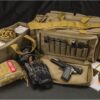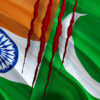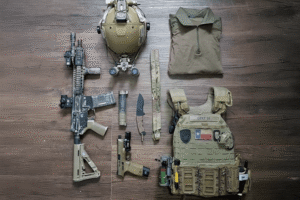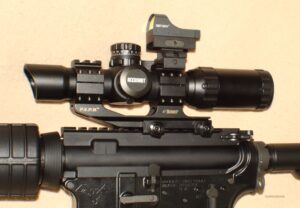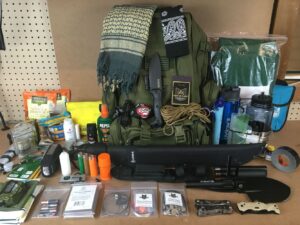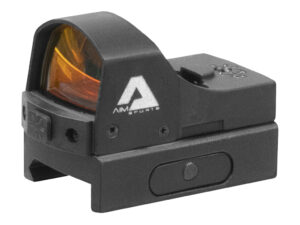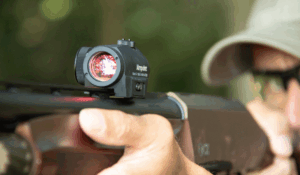
In modern shooting disciplines—whether tactical operations, competitive sports, or recreational plinking—one question frequently arises: how far can a red dot sight work effectively? Red dot optics have transformed aiming dynamics with their rapid target acquisition and intuitive reticle. Yet, understanding the true effective range of red dot sights is essential to maximize accuracy and performance. This comprehensive guide explores the science behind red dot ranges, key performance factors, and practical tips for shooters in Pakistan and beyond.
What Is a Red Dot Sight? A Brief Overview
A red dot sight is a non-magnifying reflex optic that projects an illuminated dot (usually red, sometimes green) onto a specially coated lens. This tactical optic offers:
- Unlimited Eye Relief: You can engage targets from varied cheek welds.
- Parallax-Free Design: Within a certain range, the dot remains on target even if your eye shifts behind the sight.
- 1× Magnification: No zoom—ideal for close-to-moderate distances.
Popular models in the market—especially in tactical optics Pakistan—include micro reflex sights for handguns and full-size tube sights for rifles. Their simplicity makes them a staple among professionals and enthusiasts alike.
Key Factors Affecting Red Dot Sight Range
Several variables determine how far a red dot sight work remains precise:
- Dot Size (MOA)
- Minute of Angle (MOA) indicates dot diameter: 1 MOA ≈ 1 inch at 100 yards.
- Smaller dots (1 MOA) allow finer precision at longer distances, whereas larger dots (4 MOA) facilitate quicker acquisition at close quarters.
- Optic Quality and Clarity
- Premium lenses with anti-reflection coatings improve sight picture.
- High-end models (e.g., Best red dot sights in Pakistan) often feature multi-coated, fully multi-layered optics.
- Battery Life and Brightness Settings
- Consistent illumination prevents dot fade, crucial for extended range shots.
- Adjustable brightness combats glare in daylight or low-light conditions.
- Mounting Height & Eye Relief
- Proper tactical red dot sights online mounts ensure co-witnessing with iron sights and maintain consistent cheek weld.
- Environmental Conditions
- Wind, lighting, and mirage can distort your sight picture at distance.
- Matte finishes on lenses and shades help reduce glare.
MOA Dot Size vs. Distance: Understanding Coverage
| Dot Size | Diameter at 50 yds | Diameter at 100 yds | Recommended Range |
| 1 MOA | 0.5 in | 1 in | 0–300 yds for precision |
| 2 MOA | 1 in | 2 in | 0–200 yds for general use |
| 3 MOA | 1.5 in | 3 in | 0–150 yds balanced speed |
| 4 MOA | 2 in | 4 in | 0–100 yds for CQB & self-defense |
Larger dots cover more target area quickly but obscure small targets at longer ranges. Understanding this relationship is foundational to answering how far can a red dot sight work in your application.
Determining Maximum Effective Range of Red Dot Sights
While some manufacturers advertise infinite parallax-free range, practical effectiveness diminishes beyond certain distances:
- Handgun Red Dots (e.g., on tactical shooting glasses platforms): Optimal out to 50–75 yards due to short sight radius and bulbous pistol ballistics.
- Carbine and Rifle Red Dots:
- 1 MOA dot on an AR-15: Effective aiming to 300–400 yards for point shooters.
- 2–3 MOA dots: Best for 100–200 yards general-purpose work.
- Tubed red dots combined with magnifier (1×–3×) extend reach to 500 yards or more, bridging into scope territory.
In real-world testing, many operators find their effective range capped by ballistics and shooter skill rather than the sight itself. A well-zeroed 2 MOA red dot can reliably place hits within a 4 in circle at 200 yards—sufficient for most tactical engagements.
How to Test Your Red Dot’s Range: A Step-by-Step Guide
- Zero Your Optic
- Start at 25 yards: Fine-tune elevation/windage.
- Confirm at 50 yards, then 100 yards for repeatability.
- Measure Dot Coverage
- Place a grid target at known distances (50, 100, 200 yds).
- Photograph the sight picture to visualize dot size vs. target.
- Record Group Sizes
- Fire three-round groups at each range.
- Compare point-of-impact vs. point-of-aim to calculate drift.
- Adjust Brightness
- Note dot clarity in daylight and low light.
- Optimal brightness keeps the dot crisp without bloom.
- Environmental Trials
- Shoot in varied wind and lighting to assess parallax and mirage effects.
This DIY testing allows you to quantify how far can a red dot sight work under your specific conditions.
Enhancing Distant Accuracy: Magnifiers & Hybrid Optics
To push past the innate limits of 1× optics, consider:
- Flip-to-Side Magnifiers: Paired with your red dot sight, offer 3×–5× magnification. Ideal for transitioning between CQB and mid-range.
- Prism Scopes with Red Dot Reticles: Provide fixed magnification (2×–5×) and etched reticles—no battery reliance for zeroed marks.
- Hybrid Reflex-Holographic Sights: Combine ballistic compensation reticles with unlimited eye-relief.
Such configurations answer “how far can a red dot sight work?” by effectively extending usable range while retaining rapid acquisition.
Selecting the Right Red Dot for Your Application
When shopping—particularly on tactical gear store Pakistan sites or military store online Pakistan platforms—evaluate:
- Intended Use:
- Home Defense/Self Defense Gadgets: 3–4 MOA for quick hits at <100 yds.
- Competition & Target Shooting: 1 MOA dot for sub-MOA precision at 200+ yds.
- Tactical Field Ops: 2 MOA compromise between speed and accuracy.
- Durability: Waterproof, fog-proof, and shock-resistant ratings for combat-grade reliability.
- Battery Life: Look for 50,000 + hour runtimes on medium settings.
- Mounting Compatibility: Standardized Picatinny or weaver rails, plus co-witness options with military belts and buckles for optic-mounted weapon systems.
Local favorites among the Best red dot sights in Pakistan include models from Vortex, Holosun, and Sig Sauer—trusted brands on tactical optics Pakistan catalogs.
Maintenance and Longevity Tips
To ensure consistent performance across the entire range:
- Routine Cleaning
- Use microfiber cloths and lens-safe cleaners to remove dust and fingerprints.
- Periodic Re-Zeroing
- Check zero every 500 rounds or after heavy recoil sessions.
- Battery Management
- Replace batteries yearly; carry a spare in your tactical backpack accessories kit.
- Protective Covers
- Invest in flip-cover lens caps to prevent scratches during transit.
Proper care ensures that your red dot remains capable at its maximum effective range whenever duty calls.
Troubleshooting Common Range Issues
- Dot Drift at Distance: Re-check mount torque and adapter plate alignment.
- Parallax Shift: Confirm manufacturer-rated parallax-free range and shoot within it.
- Blinding Glare: Adjust brightness or add sunshade accessories.
- Battery Flicker: Ensure contacts are clean and battery is fresh.
Addressing these glitches swiftly keeps you on target—literally.
Conclusion: Defining Your Red Dot’s Reach
So, how far can a red dot sight work? The answer hinges on:
- Dot Size (MOA) and your precision needs.
- Ballistic Capabilities of your firearm platform.
- Environmental Factors and testing methodology.
In most tactical and recreational contexts, a 2 MOA red dot provides reliable accuracy out to 200 yards, while a 1 MOA model can stretch to 300–400 yards. Coupled with magnifiers or prism hybrids, you can confidently engage targets well beyond standard reflex limits.
At RAAD Tacticals, we offer a curated selection of military tactical glasses, tactical shooting glasses, and tactical red dot sights online—all backed by expert advice and Pakistan-wide shipping. Equip yourself with the right optic, test its range meticulously, and you’ll transform theoretical reach into real-world precision.
Whether you’re zeroing in for competition, preparing for field operations, or optimizing your home defense setup, understanding the effective range of red dot sights ensures every shot counts. Reach out to RAAD Tacticals today to find your perfect red dot solution and master your maximum engagement distance.


